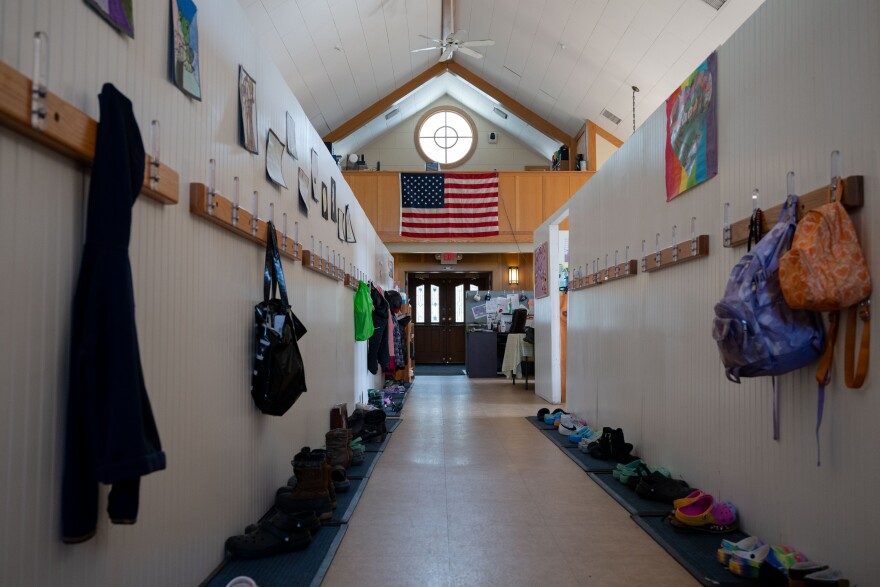It’s been almost half a year since heavy rainfall and snowmelt on a record-warm December day sent water cascading through New Hampshire's North Country. The storm cut people off from emergency services, washed out roads and bridges and wrecked homes.
It made headlines for several days.
But months later, life is still not back to normal for many of the people touched by December’s storm. For three North Country residents, the flood has been the central focus of every day since, as they navigate the liminal space between disaster and recovery.
Editor's note: We strongly recommend listening to this story by pressing the red play button above.
On the morning of the flood, Alex Roberts was in her backyard in Gorham, looking out at the Peabody River from the top of a wall that lay against the riverbank.
It was her usual spot during storms. She’d watch kayakers paddle by and try to catch the rapids.

Roberts remembers the wall — a stack of stones held together with wire, sandwiched by a rock foundation and soil on top — looking about 12 feet tall.
It’s called a gabion basket wall. Ancient Egyptians used them to protect crops and buildings from flooding and erosion along the Nile. When Roberts bought her house back in 2020, the seller’s agent and the home inspector told her the wall was built to be a barrier between the river and the road: protection from flooding.
“I was out here that day making videos,” Roberts said. “I was like, ‘This is cool to watch.’ ”
Roberts’ house sat in a small field next to that wall. It was painted dusty blue and had big windows — her dream home. She’s a photographer who mostly does weddings, but she spent hours on her porch, admiring the river and taking photos of the water.
On days when it stormed, she could track how much rain fell by looking at how high the river got. About 100 yards away was a boulder. Roberts called it “banana rock.”
“When you couldn't see any sign of banana rock, I'd be calling my neighbors to ask them how they were doing,” she said.
Hurricane Irene had flooded the property almost a decade before Roberts ever laid eyes on it. A program run by the federal Natural Resources Conservation Service built the gabion basket wall and put in other measures, like big stones and fabric, to protect the riverbank.
Satellite photos show that some of the installation seems to have been damaged in 2017 by a massive rainstorm and never fixed.
But Roberts didn’t know that when she bought the place. She didn’t even know the property had flooded before. Sellers aren’t required to disclose that in New Hampshire.

As she was buying her house, she thought the exposed, shredded fabric upstream of the wall was odd. She asked inspectors and contractors — her roofer, the people who redid her bathroom — whether they thought it looked wrong. She said she didn’t know exactly who to ask about it, but everyone she did talk to told her everything was fine. She remembers them saying that government officials were in charge of maintaining the wall.
So she settled in, enjoying her house by the river. She didn’t worry about rain.
But the December 18 storm was different. National Weather Service sites across New England hit their warmest temperature ever observed for that day. The top of Mount Washington reached a record 41 degrees. Snow in the mountains melted and mixed with the heavy rainfall.
All that water rushed into the river next to Roberts’s house. And she watched banana rock disappear faster than she’d ever seen.
“The water was splashing against the wall in a way I've never seen it splash,” she said. “I looked at the riverbank over here and boulders the size of microwaves were just falling out.”
The water was crashing against the land, ripping rocks out of the riverbank.
Roberts got more and more nervous as she refreshed a web page showing the river levels climbing.
Then, she watched as water bore a hole between the gabion basket wall and the riverbank, and peeled it away from the land. The wall crumbled. Water was approaching her house.

She was home alone, with her dog and cat. She thought: what if I get trapped inside?
“Then of course, I was like, just blood curdling screaming,” she said.
Roberts called for help.
“The people on 911 were like, ‘I can't understand you.’ Like, that’s how embarrassingly bad it was,” she said.
She tucked her animals under one arm, grabbed her work computer and hard drives full of other peoples’ wedding photos, and drove to a friend’s house.
She came back the next day. Her blue house with the big windows was unrecognizable. The water carried everything in her backyard — a trailer, a sauna, a patio with a full set of furniture and a grill — down the river.
Half of the foundation of her house was scooped out from under it, as though the flood had played a winning move in a game of Jenga.
Roberts remembers when she came back to see the damage, the sun was bright and the sky was blue.
“The birds were chirping. And I was just like, ‘A**hole of a storm,’ ” she said. “It was rough just to have it be so nice just a few hours later. And everybody's telling me that I can't live here anymore.”
Roberts and her partner stayed with a friend, and then settled into temporary housing at a church in town. Her dream home has continued crumbling slowly — the walls shifting and splitting — in the months since.
Roberts’ faith in the people and systems meant to keep her safe is cracking, too.
“I think I trusted authority figures more than I should have, being told over and over that this wall was built for this purpose. I tend to be a more trusting person than I should be,” she said.
An engineer with the federal program that built Roberts’ wall came to visit after the December storm. He said he was shocked: He’d never seen that kind of damage.
But officials mostly haven’t answered her questions about why the wall failed, and whether damage from the 2017 storm contributed to the total collapse. The Natural Resources Conservation Service says they’re studying it, and that a report they’re writing could help prevent future installations from failing. It could also result in a more robust monitoring program, or more emphasis on buyouts rather than repairs. That report may not be finished until fall.


Meanwhile, Roberts has spent months seeking information from government agencies and insurance companies, researching bankruptcy and foreclosure, and trying to get her mortgage company to call her back.
She found out just recently that the Natural Resources Conservation Service is going to help the town of Gorham buy out her property, which will help her pay off part of what she owes on the mortgage. A GoFundMe her friends set up will help, too.
But she still needs a permanent home. And wading through bureaucracy is still taking up much of her time.
“It just seems like there should be things in place to help people through events like this, but there's not,” she said.
The expectations Roberts and the rest of her community have for storms will need to change, as humans continue warming the atmosphere, and extreme precipitation events get more intense.
Now that she’s experienced a big flood, Roberts says a sense of safety she once had is gone. She doesn't want to be near water in her next home.

“[We] even looked at a property that had — I could hear a trickle under the ice, and I was like, ‘Nope, nope,’ ” she said.
Roberts has had nightmares about getting swept down the river, about her dog wondering what happened to her. Almost six months after the storm, while others in her community have moved on, she can’t.
“I'm still in it. Like, every day, all day,” she said. “I used to have days where I would talk myself out of a bad day, talk myself out of feeling bad about something easily. And now I feel like I'm talking myself into having a good day.”
‘We didn't know how long 'temporary' was going to be’
On the Monday of the flood, about 30 miles south of Roberts’ house, the Robert Frost Public Charter School in Conway was in session, winding down for the December holiday break.
A few hours after Roberts’ wall collapsed, Janine McLauchlan, the head of school, started sending students and teachers home early. She wanted them to get there before the roads flooded.

But McLauchlan had no reason to think the school would flood. The building never had flooded in the 70 or so years it stood.
That night, once everyone else was safely home, she watched water crash into the school’s first floor classrooms through a crack between a set of double doors at the back exit.
McLauchlan and her family started trying to save things. Her daughter, who teaches music at the school, perched on a stage, passing ukuleles and mini keyboards up to McLauchlan, who stood on the steps leading up to the second floor. But the water was rising too fast.
The next morning, everything was floating: tables, bookcases, shoes.
“It was just really scary,” McLauchlan said.
The school lost its whole first floor. Kids’ journals and art projects were laid out to dry.

In the months since the flood, McLauchlan has taken on a new kind of role: helping her young students understand what happened. At first, that meant lots of small search-and-rescue missions into the remnants of their old classrooms.
“For every student, it was one little thing: What did they leave behind that they really wanted to save? And then they felt so much better when they had that one thing,” she said.
The students weren’t worried about the big stuff — the destroyed kitchen, the ruined laptops. But, McLauchlan said, they wanted their shoes, their eyeglasses, their special scented markers.
As students came back to school, McLauchlan didn’t let them go downstairs. She showed the children pictures of the first floor, where the younger students’ classrooms had been, to address their fears and help them make sense of the destruction.


But that’s something McLauchlan has had a hard time with herself. Months after the flood, she was still thinking of ways she could've stopped the water — even though she knows that would've been impossible.
“I didn’t know how to prepare, because it had never happened,” she said. “It was never even in the back of my mind that this water would reach us.”
Now, all 28 students at Robert Frost — from kindergarten to high school — are sharing the second floor. It’s one big room, with short dividers serving as classroom walls.
Sometimes it gets loud. McLauchlan said the school has even started providing noise canceling headphones for some students.
She’s also doing a lot of paperwork. The school is hoping the Federal Emergency Management Agency will reimburse most of their costs. But progress has been slow. FEMA only assigned someone to their case just last month. She says she does her best to keep up with what feels like endless requests for information.

One of the hardest questions to answer is the one her students have been asking: When will they get to go back downstairs?
“It's just getting harder because I think so many of us thought, well, this is just temporary,” she said. “But we didn't know how long temporary was going to be.”
In mid-May, McLauchlan found out that they wouldn’t be able to move back into those downstairs classrooms before the end of the school year.
The church of becoming
At the Conway Village Congregational Church, just steps from the Robert Frost school, the December flood froze time.
Rev. John Hughes just got around to taking down Christmas ornaments in May.


“What happened to us was biblical. Who could have ever imagined the force of that coming down the valley and what it did? It was unimaginable,” he said.
Monday is free meal night at the Brown Church — that’s its nickname in town, because of the color of the building. The flooding started as volunteers were finishing up a special Christmas dinner service.
The water ripped out the church’s heating system and took out a 650 gallon tank of fuel oil. That contaminated the soil under the building and released fumes. The water toppled over eight refrigerators and freezers that the church had to get rid of. It soaked bookshelves and bibles beyond repair.
The flooding itself stayed on the first floor, but the damage was widespread. One of the things people have grieved most, Hughes said, is the organ. It’s from 1906, the same year the church was opened.
“The bellows were in the basement. So it brought all that moisture, all of those fumes and everything through the instrument and destroyed it,” he said. “It just had ramifications. The loss kept going and going and going.”

He’s still been leading church services, now at a theater in town, in between appointments with contractors and meetings with government officials.
He says he understands his community’s sense of grief, the feelings of loss and uncertainty. But when his congregation meets for services, he talks to them about faith.
“Great faith is when you have nothing. When you have lots of things, you don't need much faith. You just need to go along and come along,” he said. “But when you have a devastation and a loss, then we find out what faith is about. You know, the hope of things unseen and unrealized.”
In April, the congregation took a vote on what to do next. Ultimately, they decided to stick it out — try and repair the Brown Church building. They’re just starting with the top floor. Before they try to repair the downstairs, they want to know the chances of flood waters coming again.

The sanctuary won’t be reserved for Sundays. It’ll share space with community groups and meal services the church puts on for people in town. The congregation decided to restart those programs before returning for services.
The organ will be removed and replaced with an electric keyboard. Repairing it was too expensive. But once the organ is gone, Hughes says, there might be enough room for other things the building needs badly, like new bathrooms.
“I say, you're being called to things unimagined. That's what's happening. And you've got to imagine what's been unimagined and then make it happen,” he said.

As he leads his congregation, Hughes is trying to balance changes in his own life, too. He planned to retire seven years ago and hoped to travel with his wife. He has six kids and 10 grandkids, who all want to spend more time with him. Paige, who’s seven, keeps asking if he’ll take her to Paris, or teach her how to build a fire.
He’s taking some time off this summer. But, he says, he’s planning to postpone his retirement for another four years. He wants to help his congregation see past the disaster and adapt to the new threats of climate change. He wants to find a new vision for what the second floor of the old Brown Church will become, and then build it.
“It will not be the church that it has been,” he said. “It will be the church of becoming.”
Photography for this story was provided by Raquel C. Zaldívar in partnership with the New England News Collaborative













